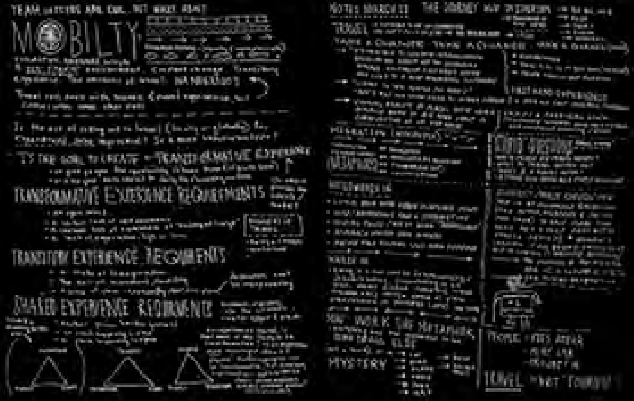Graphics Reference
In-Depth Information
12-3
A process book unfolding in time documents
the petroglyphs and pictographs of the Anasazi and
Fremont cultures of the American southwest desert
region. (Designer: Rob Carter)
As new developments arise later in the process, designers
may find it necessary to gather additional information. A designer's
curiosity is the key to informed practice and the ability to openly and
clearly communicate with colleagues and clients.
Ideating.
The worst enemy of the design process is thinking inside
the proverbial box. The mind should be open to lateral, sideways,
and unconventional thinking. Often, experienced designers rely upon
formula or knowledge-based intuition to solve problems. But these
approaches often limit the vast potential for new possibilities.
Synthesizing.
Whereas the ideation phase is concerned with
expanding possibilities, the synthesis phase concentrates on
narrowing options and coming to closure. Often, the most effective
solutions are readily apparent; they meet initial problem criteria and
are formally and aesthetically superior to weaker solutions. Short of
using sophisticated marketing techniques, the best way to evaluate
the effectiveness of a solution is to weigh it point by point against the
criteria established at the outset of the problem. However, if necessary
and appropriate, the original criteria can change at this stage and the
solution can be adjusted.
Realizing.
Implementation cannot go forward without client
approval. Usually, designers and clients communicate on a regular
basis throughout the process, which prevents confusion and
misunderstanding at the end. More often than not, clients are not
visually oriented people, thus making it the designer's responsibility to
educate them and communicate with them clearly and without the use
of jargon or highly technical language. Such communication breeds
mutual trust and respect. Upon final approval, the design moves into
final production. Successful implementation requires the designer to
manage production processes such as printing and manufacturing with
an eye on intermediate and final deadlines.
Processing typographic form and ideas
The typographic design process involves a search for typographic form
and its meaning. Any change in form (syntactics) results in a shift in
meaning (semantics). The goal of typographic problem solving is to
formulate ideas based on form and its meaning. The following methods
and techniques aid the designer in this search.
Sketchbooks and process topics.
Highly curious individuals,
designers crave visual stimuli and make a habit of recording daily
visual experiences. Through camera lens and sketchbook, they
record thoughts and images by drawing, writing, photographing, and
collecting.
Effective sketchbooks do not resemble typical scrapbooks. They
reflect ordinary as well as extraordinary experiences during the course
of everyday working and living. Sketchbooks function as a collection,
a repository of things found and observed, of the visible and invisible,
the concrete and abstract. They are both public and private.
Sketchbooks contain a variety of content, from nonsensical
doodles to visual schemas of scientific phenomena. Growing and
expanding regularly, they reflect the individual designer's mental
flights, observances, and voice (Fig.
12-2
).
While a sketchbook is a continuing exercise in recording visual
and verbal ideas, a process book records specific processes as they
unfold (Fig.
12-3
). Keeping a process book aids the designer in staying
consciously aware of the activities and thinking leading to problem
solutions.




